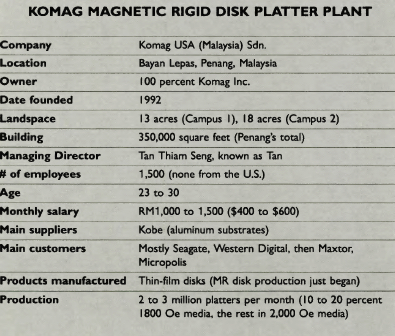History (1997): Komag Improves Yield With Automation
For manufacturing HDD platters
By Jean Jacques Maleval | October 1, 2021 at 1:30 pmKomag is, after Seagate, the world’s largest manufacturer of magnetic disk platters destined for the disk drive industry.
Its wholly-owned subsidiary, Komag USA (Malaysia) Sdn, is the world’s top supplier of thin-film media outside Japan and the US, with operations in Sarawak and Penang. Komag’s first Malaysian factory, known as Campus I, began production in 1993 in a 34,000 square meter facility located in the Bayan Lepas Industrial Park on Penang Island.
The first stage of the firm’s development (Phase I) saw 3 production lines put into place, followed by 4 more in 1994 as part of Phase II.
In January of last year, in the same park, construction began on another 22,500 square foot factory, Campus 3, designed to double the maximum disk output from Malaysian operations, thanks to an additional 5 production lines.
The first line has been operational since January of this year. The second line, which was put in place that same month, should be in production by April or May. The third line will be installed in 1997 while the remaining 2 lines will be installed in 1998.
The third Komag plant in Malaysia, Campus 2, is in the eastern state of Sarawak and produces polished substrates for use by other Komag operations.
All told, Komag had 7 functioning production lines in Malaysia by the end of 1996, along with another 10 in the US, for a total output of 11.7 million disks in the last quarter of 1996.
Asahi Glass in Japan produced 2.6 million units during the same period.
We visited Campus I in Bayan Lepas. In order to reach the installation, we had to pass through customs.
In fact, the area is a free trade industrial zone. Factories which operate there produce exclusively for export. Thus, all products which enter or are imported in the region are duty free.
By the same token, there are taxes on exports.
Even more alienating, in Komag’s facility, shoe covers are required, and must be done before one even enters the lobby.
In the cleanrooms, the level of automation is virtually total.
“We don’t hire operators here, only technicians, with at least one year of training“, explained Tan Thiam Seng, MD of the plant. “Polishing is the most difficult step, the most labor intensive. The technicians have to handle every disk. But the automated machine for this process just arrived last wek, which makes the second set implemented by the company, the first one in USA. Sputtering is the most critical process in terms of environment, requiring class 10 cleanroom. For the other steps, it’s class 100.Total monthly production is in the range of 2 to 3 million platters per month.”
He confirmed: “All 3.5-inch disks, about 10 to 20% in 1,800Oe coercivity, the rest in 2,000Oe. We just started MR platters (2,000Oe here in November and early January.”
More recently, the yield for 2000Oe media has been Komag’s greatest problem.
“Yield is a challenge. Each time we launched new media, it take a certain amount of time to reach the proper yield. This was true in 1995 with 1,800Oe media. For proximity media, we made a lot of improvement in January and February, and we are reaching the yield of 1,800Oe media,” Tan added.
Manufacturing step of HDD platter
The production process for a 3.5-inch magnetic HDD consists of six steps:
1) Plating: Through a series of chemical baths, polished aluminum substrates are plated with a uniform nickel phosphorus layer in order to provide support for the magnetic layer. 2) Polishing, 3) Texturing, and 4) Cleaning. During these steps, disks are smoothed and cleaned so that the read-write heads on the drives can fly at low and constant levels over the disks. 5) Sputtering. By a technically-demanding vacuum deposition process, the magnetic layers are successively deposited on the disk and a hard protective coating is applied. 6) Test. In robotically controlled test cells, disks are tested for a specific glide height and then certified for magnetic properties.

This article is an abstract of news published on the former paper version of Computer Data Storage Newsletter on issue 111, published on April 1997.














 Subscribe to our free daily newsletter
Subscribe to our free daily newsletter


